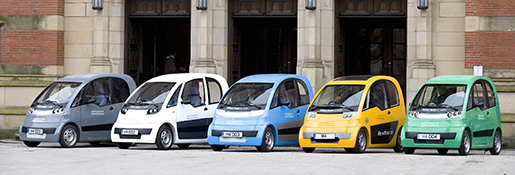When the first hydrogen-powered SWARM-project cars hit the streets of Birmingham, ahead of the expected commercial launch a year later, the emphasis will be on the vehicles’ real potential for cutting carbon emissions worldwide through the use of fuel cell technology. But as well as being green, these cars are a lot of fun to drive, too.

Zippier than conventional cars, they can accelerate away from traffic lights faster than almost any other vehicle.
Hydrogen cars – which emit only water into the atmosphere – will be more expensive to buy than petrol or diesel models, but they are cheaper to run: as the cost of petrol will continue to rise, so the cost of hydrogen from renewable energy will always go down.
The Centre for Hydrogen and Fuel Cell Research (CHFCR) doesn’t focus solely on cars, however. We are developing fuel cell systems for other modes of transport, including:
- Trains: The first prototype hydrogen-powered locomotive of its kind to operate in the UK was built by engineering students and staff. The narrow gauge loco combines a hydrogen fuel cell and lead acid batteries similar to the ones used in cars.
- Planes: We have been working with the EADS Group, a global leader in aerospace, defence and related services, to develop fuel cells for unmanned aerial vehicles.
- Boats: A hydrogen-powered canal boat has been built on campus, powered by a combination of a metal hydride solid-state hydrogen store, a proton exchange membrane (PEM) fuel cell, a lead acid battery stack and an NdFeB permanent magnet electric motor.
And it’s not only about transport – we are working on the design and production of fuel cell equipment for domestic energy supply, power generation, lorries and portable battery replacers.
In fact, we are the only UK research centre looking at all aspects of how fuel cell technologies can be harnessed to create a greener future.
Replacing fossil fuels with alternative energy sources is vitally important if we are to cut carbon emissions that contribute to global warming. But powering vehicles – as well as domestic heating and lighting systems and electrical devices – with the likes of hydrogen gas and methanol will become a reality only if they can be proven to be reliable, robust and cost-effective.
And that is our raison d'être: From basic research on fuel cells to more complex work on the integration of green energy systems into existing transport vehicles, we are road-testing the sustainable production, storage and commercial application of hydrogen and other sustainable energy sources.
Headed by Professor Robert Steinberger-Wilckens, the nationally- and internationally-acclaimed CHFCR is part of the £6.5million Advantage West Midlands Science City initiative. It was recently awarded £5.5m to create and run a doctoral training centre in hydrogen, fuel cells and their applications – the first of its kind in the UK - in 2008; currently we are looking at extending these activities to 2022.
Production
We are working on different ways to take electricity or biomass and turn it into hydrogen. A large part of our work is materials-orientated; looking at the basic science of fuel cell production and different types of cells (low and high temperatures). For example, platinum works well as a catalyst in hydrogen fuel cells, but a major drawback is that it’s expensive. So we are experimenting with:
- using less platinum more efficiently
- high temperature fuel cells more efficiently
- using high temperature fuel cells without precious metals.
Storage
Being able to store hydrogen in enough quantity at the point of need is all-important if it is to become commercially viable. We are working on metal hydride storage, which uses metal that will absorb the hydrogen and turn it into a solid. The centre is also home to the UK’s first public hydrogen filling station and there are now several around the country.